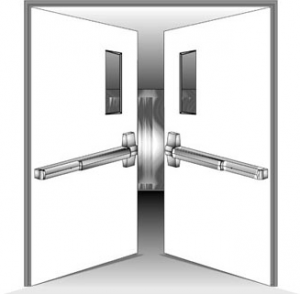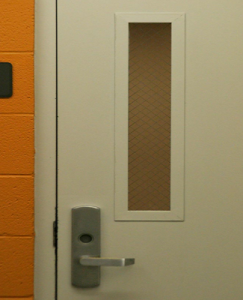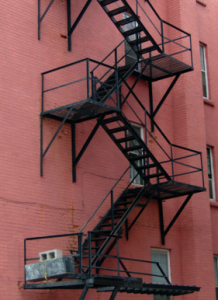To adhere to the strict Building Codes and Fire Prevention Codes set by the State, your business, home or industry must provide suitable, conforming, proper Exit devices, to keep your occupants, family and employees safe, in the event of an emergency.
Depending on the number of occupants, the rules change regarding to the type of door locks and latches that are necessary. Door exit devices are designed to be installed onto the secure side of doors that swing outwards, to prevent access whilst allowing free egress. These were designed in the United States after a significant record loss of life reports, during fires in buildings, including the loss of life of more than 600 people in the infamous Iroquois theatre fire in 1903. The exit device was the result to prevent people being crushed inside of the locked doors, as they had neither the knowledge, nor training of how to unlock and open the door. Here is some valuable information brought to you by the guys over at losangeleslocksmithpros.com.
Proper Exit Devices
 There are, to date, three common types of exit device in use today, mortise lock, vertical rod and rim lock. The latter is the most common type, being named after a latching mechanism the same as the rim locks sold in the Midwest and the East during the early part of the 20th century, these rim locks are surface mounted onto the secured part of the door face, with a latch or bolt that slides over the surface mounted strike.
There are, to date, three common types of exit device in use today, mortise lock, vertical rod and rim lock. The latter is the most common type, being named after a latching mechanism the same as the rim locks sold in the Midwest and the East during the early part of the 20th century, these rim locks are surface mounted onto the secured part of the door face, with a latch or bolt that slides over the surface mounted strike.
The mortise type lock exiting device consists of a mortise lock without deadbolt, normally mounted in the door pocket. When the push bar is pressed, the tail shaft or spindle rotates, releasing the latch bolt, enabling the door to swing open.
The bolt type of exit device is quite a new introduction, which, when locked, causes the deadbolt latch to extend onto the strike, which limits the space between the strike and the bolt.
Exit devices are categorised as being either non fire rated (Panic) or fire rated exits.
Approved Panic Hardware
This must consist of a door latching assembly, with an activating device that will cause the door to unlatch and open in the direction of egress opening, when a force is applied. The approved building codes state that it the panic approved latch must have an unlatching force of a maximum of 15 pounds, and be opened by anyone without specialist knowledge, effort or training.
Approved Fire Exit Hardware
 This classicisation of door latch is required when fitted to a fire door, which is providing a smoke and fire barrier to the opening. Swinging fire doors must be capable of self-closing, and automatically latching after every use. The door may be latched, as with a Panic door, but must not be locked whilst occupants are inside the building.
This classicisation of door latch is required when fitted to a fire door, which is providing a smoke and fire barrier to the opening. Swinging fire doors must be capable of self-closing, and automatically latching after every use. The door may be latched, as with a Panic door, but must not be locked whilst occupants are inside the building.
Stairwell Door Locking Hardware
Door locking hardware used in stairwells, must of course meet the strict building safety codes. Occupants using the stairs, in the event of an emergency, must always be able to leave the stairwell and enter into another room or corridor, the door must not lock to prevent them this access.
Required Exit Doors
It is a standard requirement that all exterior exit doors, when there are occupants present inside the building, open into the way of egress, must open without the need for keys, tools, special equipment, strength or specialist knowledge. Any locks or security devices that are not approved must be removed and replaced with those that conform to regulated building codes.
Illuminated Stair and Exit Signs
All signs used in these areas must be fully functioning, readable and intact.
Fire Escape Stairs
 These stairways must be maintained, in very good condition and state of repair. Any obvious obstructions such as air conditioning units, plant pots, boxes and furniture must be removed, and the bottom section of the fire escape ladder must be free from obstruction, such as waste containers or cars.
These stairways must be maintained, in very good condition and state of repair. Any obvious obstructions such as air conditioning units, plant pots, boxes and furniture must be removed, and the bottom section of the fire escape ladder must be free from obstruction, such as waste containers or cars.
The need to get your building up to code with these specialist exit devices, is a necessity that you cannot avoid at any expense. Exit devices have been produced and marketed for around 100 years, with continuous, increased capabilities and improvements. As with all of these exit devices, for more information consult your local locksmith for valid advice.
